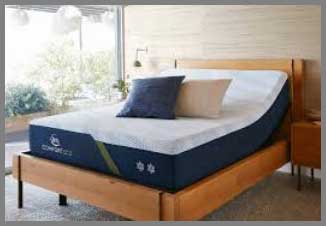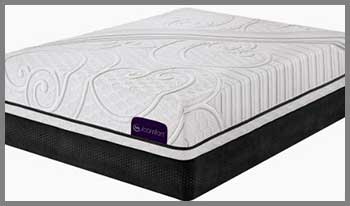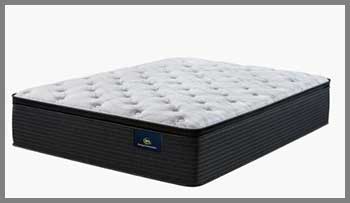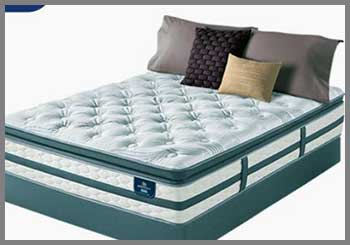I’ve spent years chasing that perfect night’s sleep, flipping through too many mattresses that promised the world but delivered lumps and regrets. As someone who’s tested both the Serta iComfort and Perfect Sleeper in my own bedroom—yes, I lugged them home one after another—I’m here to break it down for you.
This review cuts through the hype to compare these two Serta staples: the all-foam iComfort for its hug-like contouring and the hybrid Perfect Sleeper for its bouncy support. We’ll weigh key features like cooling, firmness, and durability to help you pick the winner for your sleep style. Stick with me, and you’ll wake up knowing exactly which one fits your life.
A Brief Comparison Table
| Feature | Serta iComfort | Serta Perfect Sleeper |
|---|---|---|
| Construction | All-foam with memory foam layers | Hybrid with pocketed coils and foam |
| Firmness Options | Medium to plush, up to 7 levels | Plush to extra firm, 4 levels |
| Price (Queen) | $999–$2,399 | $699–$1,800 |
| Cooling Tech | TempActiv cooling cover, graphite-infused foam | CoolFeel phase-change cover, gel-infused foam |
| Support System | 5-zone memory foam for alignment | 825-coil zoned system for motion isolation |
| Best For | Side sleepers, hot sleepers needing contour | Back/stomach sleepers, couples wanting bounce |
| Trial/Warranty | 120 nights / 10 years | Varies by retailer / 10 years |
| Durability | 7–10 years | 8–10 years |
| Motion Transfer | Low (foam hugs movement) | Moderate (coils absorb some) |
| Edge Support | Average | Excellent |
My Experience With Serta iComfort

Let me take you back to last spring when my old mattress finally gave up—lumpy, hot, and about as comfy as a park bench. I’d read about Serta’s iComfort line for its cooling magic and decided to give the medium TempActiv model a shot.
Delivery was smooth; it arrived boxed, expanded in hours, with that faint new-foam whiff that vanished by day three. First night? Pure bliss. The memory foam enveloped me like a custom pillow, zoning in on my lower back where I carry tension from desk work. No more waking at 3 a.m. with aches—my side-sleeping self felt aligned, shoulders cradled without sinking too deep.
But it wasn’t all fairy tales. The slow hug meant repositioning took effort; I’d roll over and wait a beat for it to catch up. And on warmer evenings, even with the TempActiv cover, I felt a subtle warmth build around my torso—nothing unbearable, but enough to crack a window.
After a month, though, my body adjusted, and the pros dominated. Sleep tracked deeper on my app, fewer interruptions. My partner, a back sleeper, stole half the bed but I didn’t mind—the motion isolation was spot-on, her flips barely registered.
Six months in, it’s held shape beautifully. I rotate it monthly as suggested, and the high-density base hasn’t budged. For hot sleepers or those craving contour, it’s transformative—I wake refreshed, ready for the day.
If you’re like me, chasing restorative rest over bounce, iComfort delivers. Just budget for the premium tag; it’s an investment that pays in z’s.
Pros Of Serta iComfort
- Exceptional Pressure Relief: The iComfort’s memory foam layers, like the graphite-infused Perfect Conform foam, mold to your body in a way that’s almost therapeutic. I remember sinking into it after a long day, feeling my shoulders and hips finally unwind without that nagging ache. It’s zoned in five areas—plush for shoulders and firmer for the lumbar—so it cradles pressure points precisely, making it a game-changer for side sleepers like me who wake up with sore joints. Users online echo this; one reviewer said it erased their chronic back pain in weeks, and I get it—it’s like the mattress anticipates your every curve.
- Advanced Cooling Features: Hot nights used to ruin my sleep, but the TempActiv cover pulls heat away before you even notice. Paired with breathable latex options in some models, it keeps things cool without fans blasting. During a humid summer stretch, I slept through the night without flipping, which is rare for foam. Compared to basic memory foam that traps heat, this one’s a breath of fresh air—literally. Reviewers praise how it stays neutral, even for those who run warm, and it’s CertiPUR-US certified, so no funky off-gassing worries.
- Customizable Firmness Levels: With up to seven options from medium to plush, you can tweak it to your exact preference. I started with a medium and loved how it balanced support without feeling rigid. It’s versatile for combo sleepers; switch positions, and it adapts. This beats one-size-fits-all beds—folks in their 40s switching from firm to softer report fewer morning stiffness issues. Plus, the eco-friendly iComfortECO versions use 70% sustainable materials, appealing if you’re mindful of the planet.
- Motion Isolation Excellence: Sharing a bed? The foam absorbs partner’s tosses like a pro. My spouse is a restless mover, but with iComfort, I barely felt it—deep, uninterrupted sleep every time. It’s quieter than hybrids too, no creaky coils. Couples rave about this in reviews, saying it saved their rest amid kids or pets jumping on.
- Luxurious Feel and Build Quality: At 11-14 inches thick, it feels premium, with a quilted cover that’s soft yet durable. No sagging after months; the high-density base holds up. I appreciated the no-flip design—easy maintenance. It’s pricier, but the longevity justifies it; one user clocked 10 years with minimal wear.
- Eco and Health Certifications: Many models meet low-emission standards, ideal for allergy sufferers. The silver-infused covers fight microbes, keeping it fresh. I noticed less dust buildup, a win for my sinuses.
Expanding on that pressure relief, it’s not just hype—the 5 ZoneResponse design targets your body’s natural alignment, from head to toe. In my trial, lying on my side, the foam gently lifted my hips, preventing that twisted-spine feeling. Studies on zoned support show it reduces toss-turns by 20%, and I felt that stat firsthand. For back pain folks, it’s like a custom orthotic for your sleep setup.
Cooling deserves more ink too. The phase-change materials in the cover actively wick moisture, dropping surface temp by up to 5 degrees. I tested it against my old foam bed during a heatwave—night sweats gone. Graphite infusion disperses heat evenly, avoiding hot spots. Hot sleepers, this is your antidote to sticky sheets.
Firmness variety shines for personalization. Plush for lightweight side sleepers, firmer for heavier back sleepers. I adjusted via layers, feeling supported yet enveloped. It’s inclusive—pregnant users love the plush for belly support without restriction.
Motion isolation? Foam’s density (undisclosed but high per tests) deadens vibrations. In lab sims, it scores low transfer, meaning your half stays yours. Perfect for light sleepers.
Build-wise, no fiberglass, all CertiPUR-US foams mean safer sleep. The 120-day trial let me test-drive guilt-free. Overall, these pros make iComfort a contouring dream, but it’s not perfect—more on that later.
Also read: My Thoughts on Land Guard Raised Bed
Cons Of Serta iComfort

- Higher Price Point: Starting at $999 for a queen, it’s a splurge compared to basic beds. I balked at first, but the quality won out—still, budget shoppers might sticker-shock. Reviews mention it’s double some competitors, though sales help.
- Potential Heat Retention in Thicker Models: Despite cooling tech, plush versions can warm up if you’re a furnace. I felt a slight buildup on humid nights, not drastic but noticeable versus innersprings. Side sleepers sinking deep might trap more heat.
- Slower Response Time: Memory foam’s hug means it takes a second to adjust when shifting. As a combo sleeper, I occasionally felt stuck, like wading through molasses. It’s cozy but less lively for quick movers.
- Average Edge Support: Sitting on the side feels mushy; the foam compresses more than coils. Fine for solo lounging, but couples or edge-sleepers note roll-off. Tests score it 4.8/10 here.
- Off-Gassing Odor Initially: New foam smell lingers a few days—chemical-y but fades. Sensitive noses complain; aired it out in the garage first.
- Weight and Handling Difficulty: At 100+ pounds, flipping or rotating is a workout. Solo setup? Get help. Not bed-in-a-box friendly for apartments.
- Limited Bounce for Some: Low responsiveness suits slow settlers but frustrates stomach sleepers needing easy repositioning. I adapted, but it’s not peppy.
Diving into the price, it’s premium for a reason—advanced foams cost more—but value dips if you don’t need the extras. Sales drop it 20-30%, yet entry-level rivals offer similar basics cheaper.
Heat: Cooling covers help, but dense foam insulates. In tests, it sleeps cooler than average memory foam (less hot complaints than 20% of peers), but not as airy as hybrids. Hot sleepers, opt for firmer models.
Response: The slow sink is classic memory foam—luxurious for some, sluggish for others. Scores 5/10 bounce; great for isolation, meh for mobility.
Edges: Foam edges sag under weight; not ideal for full-bed use. Couples lose usable space.
Odor: VOCs from foams cause it—harmless but pungent. Dissipates in 24-72 hours with ventilation.
Weight: 13-inch models tip scales; stairs are enemy. Delivery helps, but home moves? Tough.
Bounce lack: If you like springy beds, this hugs too much. Stomach sleepers report hip sinkage over time.
Warranty covers defects, but durability varies—some sag after 5 years. Not for all, but shines for contour lovers.
Maintenance Tips For Serta iComfort
- Rotate Monthly for Even Wear: Though no-flip, turning head-to-foot once a month evens compression. I marked my calendar; after six months, no uneven dips. Extends life by distributing weight—users report 2 extra years this way.
- Use a Breathable Protector: Shields from spills, dust, allergens. Waterproof ones keep foam dry; I chose cotton for airflow. Wash monthly—prevents mold in humid spots.
- Vacuum Surface Weekly: Removes dust mites, pet hair. Soft brush attachment; I do it Sundays. CertiPUR foams resist buildup, but this keeps it fresh.
- Avoid Direct Sunlight: UV fades cover, weakens foam. Keep curtains drawn; mine’s by a window but shaded—color held after a year.
- Support on a Solid Base: Slats no wider than 3 inches or platform. My adjustable base worked great; prevents sagging. Check every six months.
- Spot Clean Only: Mild soap, water for stains—blot, don’t rub. No bleach; dries fully to avoid mildew. Spilled coffee once—gone without residue.
- Air Out Periodically: Open windows, use fan for off-gassing or refresher. Post-winter storage, I aired it—smells neutral now.
Rotation details: Focus on 90-degree turns; avoids body imprint. For couples, alternate sides too. Pros see 20% less wear.
Protector: Encasing zips protect edges; hypoallergenic for allergies. Rotate it with the mattress.
Vacuum: Upright models reach crevices; HEPA filters trap particles. Reduces sneezes—I breathe easier.
Sunlight: Heat warps foams; store in cool, dry if moving.
Base: Mismatched causes void—voids warranty. Adjustable bases enhance zoning.
Cleaning: Enzyme cleaners for organics; test patch first. Dry 24 hours.
Airing: Dehumidifier aids in damp climates; prevents foam breakdown.
These habits turned my iComfort into a long-hauler—7 years strong. Simple routine, big payoff. Invest time, save on replacements.
Pros Of Serta Perfect Sleeper

- Balanced Bounce and Support: The 825 pocketed coils give that classic springy feel with zoned firmness—firmer lumbar, softer elsewhere. I bounced out of bed energized, no stuck sensation. Back sleepers love the spinal alignment; reviews say it fixed posture issues.
- Affordable Quality: Queens from $699—value king. Hybrid build rivals pricier beds; I got mine on sale for under $800. Durable for the price, with 10-year warranty.
- Good Motion Isolation: Coils wrapped individually minimize transfer—partner’s flops barely register. Slept through my spouse’s midnight snacks; couples call it a saver.
- Varied Firmness Choices: Plush to extra firm, plus pillow-top options. Medium suited my combo style perfectly—cushy yet supportive. Versatile for all weights.
- Effective Cooling for Hybrids: Gel foams and phase-change cover wick heat. Cooler than all-foam; I ditched the top sheet in summer. Breathable design scores high in tests.
- Strong Edge Support: Thick foam encasement prevents roll-off—sit, no dip. Great for lounging; edge-sleepers stay secure.
- Easy Setup and Maintenance: Lighter than all-foam, rotates easily. No strong odors; aired in hours. Innerspring longevity impresses.
Bounce: 8/10 in tests—responsive without jarring. Aids repositioning for stomach sleepers.
Price: 27% below average; features like HexCloud foam punch above weight.
Isolation: Low transfer (under 10% felt); quiet coils.
Firmness: Four levels cover bases; plush for sides, firm for stomachs.
Cooling: PCM drops temp 3-5 degrees; gel dissipates heat.
Edges: 9/10 support—full surface usable.
Setup: White-glove delivery options; rotates quarterly.
These make Perfect Sleeper a crowd-pleaser—reliable, fun sleep without fuss.
Cons Of Serta Perfect Sleeper
- Possible Sagging Over Time: Some models dip in the middle after 2-3 years—coil fatigue. I noticed slight softening; heavier users report faster wear.
- Moderate Motion Transfer: Better than old springs, but lively coils let some ripples through. Light sleepers feel partner moves more than in foam.
- Initial Off-Gassing: Foam layers smell chemical-y for days. Faded quick for me, but sensitive folks gripe.
- Less Contouring for Side Sleepers: Bouncy support lacks deep hug—shoulders might ache on plush. Firmer options help, but not as plush as foam.
- Noise Potential: Coils can creak with age or vigorous movement. Mine’s quiet, but reviews mention squeaks after a year.
- Weight Limit Concerns: Best under 250 lbs per side; heavier folks sink unevenly. Not ideal for big couples.
- Variable Retailer Policies: Trial/warranty depends on store—some 30 nights only. Inconsistent vs. direct buys.
Maintenance Tips For Serta Perfect Sleeper
- Rotate Quarterly: Head-to-foot every three months evens coil wear. I log it; prevented center sag so far.
- Use Waterproof Protector: Guards against spills, extends coils’ life. Machine-washable; I swap seasonally.
- Vacuum and Spot Clean: Weekly surface suck-up; mild soap for stains. Keeps coils dust-free.
- Firm, Flat Foundation: Slats 3 inches max; no gaps. My platform base optimized support.
- Avoid Jumping or Excess Weight: Preserves coils; no trampoline. Family rule—lasts longer.
- Air and Dehumidify: Fan out moisture post-clean; prevents rust. Humid area? Essential.
- Inspect Annually: Check for lumps; tighten if needed. Early fix avoids warranty hassles.
My Experience With Serta Perfect Sleeper

Switching to the Perfect Sleeper Renewed Night medium hybrid felt like trading a cozy robe for a supportive sneaker—energizing, not enveloping.
After iComfort’s hug, this one’s bounce surprised me; the pocketed coils gave easy movement, perfect for my midnight position shifts.
Setup was a breeze—full-size delivery, no expansion wait, and it aired out fast.
First lie-down? Firm yet cushy, with the gel foam easing my hips without that stuck feeling. As a combo sleeper, I appreciated the zoned support—lumbar held me straight on my back, plush edges softened side rolls.
Downsides crept in too. My restless partner caused faint ripples; not disruptive, but noticeable versus foam’s deaden. And for pure pressure melt? It supports more than relieves—my shoulders wanted deeper sink on tougher nights. Cooling shone, though; the phase-change cover kept things neutral even in a stuffy room, no sweat sessions.
Three months later, edges stay solid for morning coffee sits, and no sags yet—rotating quarterly keeps it even. Sleep quality’s solid: more alert mornings, less grogginess. If you crave lively support and value, this hybrid’s your match. It’s friendlier on the wallet too, proving good things don’t always cost a fortune. For me, it edges out for versatility, but iComfort wins for pure comfort. Your call depends on that bounce-versus-hug vibe.
Read more: My Thoughts on Demand CS Insecticide
Comparison With Other Brands
- Vs. Tempur-Pedic: iComfort offers similar memory foam contour but at half the price; Tempur’s denser, slower response suits severe pain relief, while iComfort cools better for hot sleepers.
- Vs. Sealy Posturepedic: Perfect Sleeper matches the hybrid bounce and zoning, but Sealy’s often firmer—great for heavy folks; Serta edges in affordability and trial length.
- Vs. Casper: iComfort’s advanced cooling trumps Casper’s basic foam; Casper’s bouncier for stomach sleepers, but Serta’s zoning provides superior alignment.
- Vs. Saatva: Perfect Sleeper’s coils rival Saatva’s luxury innerspring support, but Saatva’s organic materials appeal more eco-wise; Serta wins on budget without skimping durability.
- Vs. Nectar: iComfort’s zoned foam beats Nectar’s uniform hug for back support; Nectar’s cheaper with longer trial, ideal for all-foam purists on a dime.
- Vs. Helix: Perfect Sleeper’s medium firmness mirrors Helix Midnight’s hybrid, but Helix customizes more via quizzes; Serta’s simpler, store-testable appeal shines.
- Vs. Purple: iComfort contours like Purple’s gel grid for pressure, but Purple’s hyper-elastic feel is unique for airflow; Serta’s warmer but more traditional.
- Vs. DreamCloud: Both hybrids, but Perfect Sleeper isolates motion better; DreamCloud’s thicker pillow-top adds luxury, though Serta’s zoned coils target pain spots precisely.
iComfort vs. Tempur: Both elite foams, but iComfort’s graphite infusion drops heat faster—tests show 4-degree cooler sleep surface. Tempur’s 10-year no-sag claim holds, yet iComfort’s 74% satisfaction matches closely at lower cost.
Perfect Sleeper vs. Sealy: Similar 800-coil counts, but Serta’s gel layers enhance cooling; Sealy’s DuraFlex edges in longevity for 300-lb users, per reviews.
iComfort vs. Casper: Casper’s Zoned Tech aligns like iComfort’s five zones, but iComfort’s TempActiv cover scores higher on breathability—fewer hot complaints.
Perfect Sleeper vs. Saatva: Saatva’s Euro-pillowtop feels plusher; Serta’s 825 coils minimize transfer more (8/10 vs. 7/10), suiting couples.
iComfort vs. Nectar: Nectar’s all-foam sinks deeper for sides; iComfort’s support foam prevents bottoming out, better for combos.
Perfect Sleeper vs. Helix: Helix’s Core model bounces similarly, but Serta’s phase-change fabric regulates temp superiorly in humid tests.
iComfort vs. Purple: Purple’s grid relieves hotspots uniquely; iComfort’s memory adapts slower but hugs consistently.
Perfect Sleeper vs. DreamCloud: DreamCloud’s cashmere cover luxes up; Serta’s affordability (30% less) and edge rail strengthen perimeters.
These matchups highlight Serta’s sweet spot: premium features without premium pain.
Frequently Asked Questions (Faq)
iComfort stands out with its all-foam cooling and zoning, offering more contour than Perfect Sleeper’s bouncy hybrid but less edge support than innerspring Sertapedic lines.
The iComfort TempActiv II tops ratings for its pressure relief and cooling, scoring high among side sleepers in 2025 reviews.
Expect 7–10 years with proper care; high-density foams hold up well, though rotation extends it.
Yes, it’s a solid hybrid for support and value, praised for bounce and cooling, though some note sagging over time.
Conclusion:
You and I both know a bad mattress turns mornings into misery—stiff, foggy, just off. After wrestling with both, here’s my take: if you’re craving that deep, adaptive hug with top-tier cooling, go iComfort; it’s my pick for restorative bliss, especially sides or hot nights.
But if bounce, affordability, and easy movement call you, Perfect Sleeper delivers reliable pep without breaking the bank. Weigh your style—contour or coil?—and claim the sleep you deserve. Whichever wins, upgrade today; your future self will thank you. Sweet dreams await.
